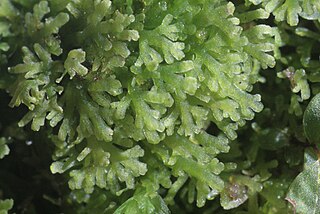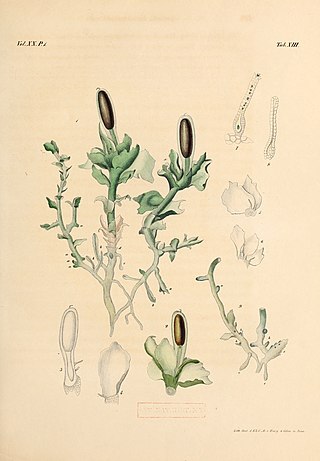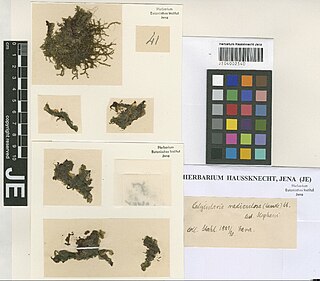
The Marchantiophyta are a division of non-vascular land plants commonly referred to as hepatics or liverworts. Like mosses and hornworts, they have a gametophyte-dominant life cycle, in which cells of the plant carry only a single set of genetic information.

Barthélemy Charles Joseph Dumortier was a Belgian who conducted a parallel career of botanist and Member of Parliament.

Metzgeriales is an order of liverworts. The group is sometimes called the simple thalloid liverworts: "thalloid" because the members lack structures resembling stems or leaves, and "simple" because their tissues are thin and relatively undifferentiated. All species in the order have a small gametophyte stage and a smaller, relatively short-lived, spore-bearing stage. Although these plants are almost entirely restricted to regions with high humidity or readily available moisture, the group as a whole is widely distributed, and occurs on every continent except Antarctica.

Takakia is a genus of two species of mosses known from western North America and central and eastern Asia. The genus is placed as a separate family, order and class among the mosses. It has had a history of uncertain placement, but the discovery of sporophytes clearly of the moss-type firmly supports placement with the mosses.

Sphaerocarpaceae is a family of liverworts known as bottle liverworts. Approximately ten species are included in this family, most of them in the genus Sphaerocarpos, but one additional species in the genus Geothallus.
Noteroclada is a small genus of liverworts of the Southern Hemisphere. It is classified in order Pelliales and is the only genus in the family Noterocladaceae within that order. Unlike Pellia, the other genus in the order, Noteroclada has a leafy appearance.
Phycolepidozia exigua was thought to be the only species of liverwort in the genus Phycolepidozia and family Phycolepidoziaceae. Until another species was found. Phycolepidozia exigua is endemic to Dominica, where it is critically endangered. Its natural habitat is subtropical or tropical moist lowland forests.

Haplomitriopsida is a newly recognized class of liverworts comprising fifteen species in three genera. Recent cladistic analyses of nuclear, mitochondrial, and plastid gene sequences place this monophyletic group as the basal sister group to all other liverworts. The group thus provides a unique insight into the early evolution of liverworts in particular and of land plants in general.

Monoclea is a genus of liverwort that contains two species. It is the only genus in the family Monocleaceae. Species of this genus can be found in New Zealand, South and Central America as well as in the Caribbean.

Phyllothallia is a small genus of liverworts of the Southern Hemisphere. It is classified in the order Pallaviciniales and is the only member of the family Phyllothalliaceae within that order. Unlike most members of the Metzgeriales, Phyllothallia has a leafy appearance. The genus has a disjunct distribution, with the species Phyllothallia nivicola found in New Zealand while the other species in the genus, Phyllothallia fuegiana, occurs in Tierra del Fuego.

Sandeothallus is a small genus of liverworts restricted to East Asia. It is classified in the order of Pallaviciniales and is the only member of the family, Sandeothallaceae within that order.
Allisonia cockaynei is the only species of liverwort in the genus Allisonia and family Allisoniaceae. It is endemic to New Zealand.
Makinoa crispata is the only species of liverwort in the genus Makinoa and family Makinoaceae. The genus Verdoornia was formerly included in this family, but has been transferred to the family Aneuraceae on the basis of recent cladistic analysis of genetic sequences.

Pleurozia is the only genus of liverworts in the family Pleuroziaceae, which is now classified in its own order Pleuroziales, but was previously included in a broader circumscription of the Jungermanniales. The genus includes twelve species, and as a whole is both physically distinctive and widely distributed.

Ptilidium is a genus of liverwort, and is the only genus in family Ptilidiaceae. It includes only three species: Ptilidium californicum, Ptilidium ciliare, and Ptilidium pulcherrimum. The genus is distributed throughout the arctic and subarctic, with disjunct populations in New Zealand and Tierra del Fuego. Molecular analysis suggests that the genus has few close relatives and diverged from other leafy liverworts early in their evolution.
Neotrichocoleaceae is a family of liverworts in order Ptilidiales. It is closely related to the genera Ptilidium and Herzogianthus.
Calycularia is the only genus of liverwort in the family Calyculariaceae. It was formerly included within the Allisoniaceae, and it includes only two species.
Victor Félix Schiffner was an Austrian bryologist specializing in the study of hepatics.

Asterella californica is a complex thallic liverwort in the phylum Marchantiophyta. A. californica often grows as colonies of flat rosettes of light green, rigid thalli, with undersides dark wine-red to nearly black. The receptacles are rounded, with four lobes each bearing a single sporangium sheathed by a white tattered skirt. A. californica is dioecious with separate male plants often intermingled with female plants. This species is found throughout California from San Francisco southward to San Diego and Guadalupe Island. Asterella californica is the commonest species of the three species of Asterella occurring in California; the other two species are A. bolanderi and A. palmeri.

Cryptomitrium tenerum is a species of liverwort native to North America. It is the only representative of its genus on the continent.













